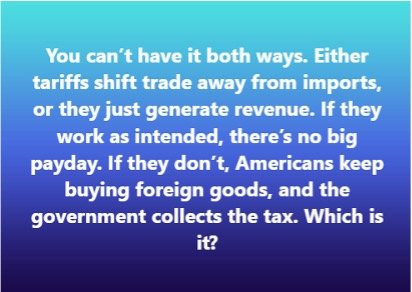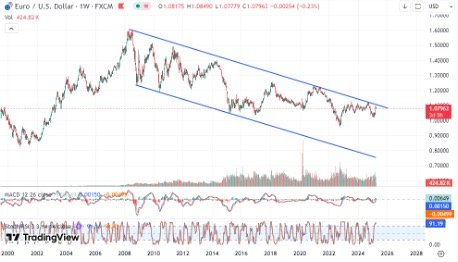
With the Trump administration’s reciprocal tariffs now in effect, many are questioning their economic impact. But what’s really happening behind the scenes? Let’s take an objective look at the economic landscape and what it means for investors.
The Political and Economic Strategy Behind Tariffs
President Trump doesn’t have to be overly concerned with immediate stock market fluctuations or inflation during the early part of his term. If markets falter, he has the luxury of attributing the downturn to the previous administration’s policies. However, his real challenge will come in a dip occurs later during his term—if economic instability arises closer to the next election, it will be much harder to shift the blame. His priority is to ensure the economy remains resilient in the long run, and it needs to be moving in the right-direction, before he hands over the baton!

The key issue with tariffs is the way they are perceived. Many countries avoid discussing the “reciprocal” aspect of Trump’s policy, as doing so would expose their own reliance on tariffs to bolster their economies. For years, other nations have imposed trade barriers on American goods, benefiting from a trade imbalance. The current policy shift is an attempt to level the playing field, and while some may resist the change, the reality is that no country should expect to take advantage of a wealthier partner indefinitely.
The Role of Global Politics in Tariff Reactions
Politics complicates the issue further. Certain economic blocs, such as the European Union, are not aligned with Trump’s nationalist approach. Rather than reducing tariffs on U.S. goods to stabilize trade relations and curb inflation, European policymakers have responded by increasing their own tariffs. This response exacerbates economic tensions and suggests that political motivations are often prioritized over the well-being of taxpayers and consumers.
In my previous reports (February 6 and 19), I discussed the potential consequences of a tariff war and its impact on global equity markets. As we are now witnessing, many of those concerns are materializing. What has been surprising, however, is the strength of the British pound (GBP) and the euro (EUR) since those reports. It appears that traders believe the tariffs will have a greater negative impact on the U.S. economy than on European economies. Whether this belief holds true remains to be seen in the coming months.
Currency Trends and Market Outlook
Since the 2008 financial crisis, both the euro and the pound have been in a long-term downtrend, and there were no clear signs of sustained dollar weakness during Trump’s previous tenure. While historical trends suggest continuity, financial markets are always subject to change, and long-standing trends can break under the right conditions.

That said, my investment stance remains unchanged since Trump’s election victory. While global equity markets may see corrections following two years of robust growth, I ultimately expect the U.S. dollar to perform well against other major Western currencies.
A key factor to watch is central bank policy. The European Central Bank (ECB) has a meeting on April 17, where they may choose to delay their next interest rate cut until June. Meanwhile, the Bank of England’s direction remains uncertain. UK government policy is making the job of the Bank of England a fool’s errand—attempting to control currency valuations through interest rate adjustments is challenging, especially when the countries fiscal policies lack coherence and economic fundamentals are ignored.
The Future of Tariffs and Commodities
The coming months will be telling, but by the time summer arrives, I expect tariff-related concerns will have faded from the headlines.
The bigger question now is: what will happen to gold?

Gold has surged by 50% in just over 15 months, with half of that increase occurring after Trump’s election. Many analysts attribute this rally to tariff-induced uncertainty. While it’s clear that tariffs have influenced investor sentiment, predicting the next move for gold is difficult given the current uncharted market conditions. I recently took a position by selling some 3350 calls expiring next month, and while this may not be my best trade of the year, a dip or even a temporary pause in gold’s rally could still work in my favour.
Oil prices, particularly WTI crude, also experienced a strong rally last week before facing resistance. This pullback was partly due to Trump’s threats of sanctions on Russian oil buyers, particularly China and India. Additionally, downward pressure on prices comes from the upcoming OPEC meeting on Thursday, where a decision on extending output increases beyond April is expected. That said, we have to watch what happens to Oil exports out of Iran and Venezuela, as sanctions on these countries may not help with Trumps aim of lowering oil prices.
Final Thoughts
Although markets are fluctuating due to tariff policies, currency shifts, and commodity trends, maintaining a long-term perspective is essential. In the short term, speculation may yield better results than long-term investments, but we must not lose sight of broader market trends. Additionally, staying informed about the rapidly evolving geopolitical landscape is crucial for assessing its impact on the economy and our markets.
The post How Tariffs, Currencies and Commodities Are Shaping the Market first appeared on JP Fund Services.
The post How Tariffs, Currencies and Commodities Are Shaping the Market appeared first on JP Fund Services.
The post How Tariffs, Currencies and Commodities Are Shaping the Market first appeared on trademakers.
